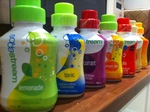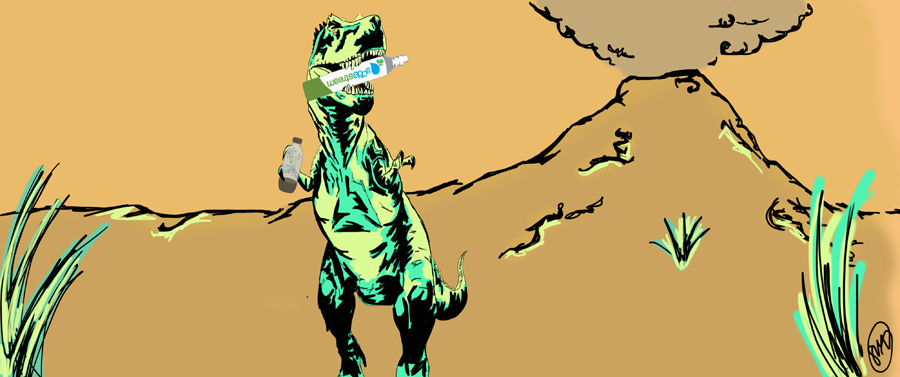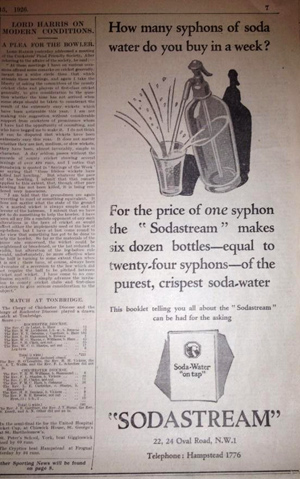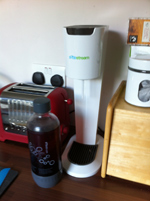A couple of weeks ago, much to my delight, my esteemed colleague Bobert forwarded me a clipping from a newspaper from 1926 showing an advert for SodaStream (see picture to the left) and it got me thinking about the origins of SodaStream. I knew the product went back further than my first glimpse of the brand in the 1980s, but I realised that I didn’t know much about the Sodastream story and that it was high time I donned my best investigative deerstalker hat, whipped out the old reporters shorthand notebook and biro and did some hard-nosed reporting on the origins of the great purveyor of fizz. So, here is my breakdown on the history of SodaStream:
Ancient fizztory
Since mankind has been bathing in natural spring water, people have been extolling the virtues of doing so and given that some mineral water is naturally fizzy due to the presence of carbon dioxide, we can safely assume that humans have been drinking fizzy water since the dawn of time. Where we think of the Egyptians watching their boundary stones and whipping their slaves in the pursuit of constructing giant stone monuments we should see them satiating their thirst on a glass of fizzy water, flavoured by honey, lemons or rosewater. Where we dream back to Cleopatra facing off against the romans and bathing in milk we should imagine she did so, comforted by a glass of pop. We don’t know a huge amount about these drinks, but we do know that up to relatively modern times it was common to provide distilled drinks such as beers or other alcohol to ensure that the water was safe to drink and that flavouring water has existed as a practice from ancient times, as much to prevent it tasting foul as to add to the interest.
The invention of carbonation
 The prodigious chemist, inventor and chum of Benjamin Franklin, Joseph Priestley (1733-1804), spent a period of his life investigating gases and is credited with the discovery of oxygen (though he named the gas with the rather cumbersome title of dephlogisticated air), along with hydrochloric acid, nitrous oxide (laughing gas), carbon monoxide and sulfur dioxide. In 1767, no doubt parched from his efforts generally discovering everything, Joseph produced the first drinkable manmade glass of carbonated water, using a process involving suspending a bowl of water above a beer vat at a local brewery in Leeds, England. The refreshment produced from this experiment enabled him to concentrate on various experiments related to electricity and carbon dioxide over the next few years, before in 1772 he realised it was high time he published his findings in the paper “Impregnating Water with Fixed Air”, but he never exploited the business potential of making fizzy water, believing at the time (erroneously) that the best use of his product was in the preventing of scurvy on naval vessels.
The prodigious chemist, inventor and chum of Benjamin Franklin, Joseph Priestley (1733-1804), spent a period of his life investigating gases and is credited with the discovery of oxygen (though he named the gas with the rather cumbersome title of dephlogisticated air), along with hydrochloric acid, nitrous oxide (laughing gas), carbon monoxide and sulfur dioxide. In 1767, no doubt parched from his efforts generally discovering everything, Joseph produced the first drinkable manmade glass of carbonated water, using a process involving suspending a bowl of water above a beer vat at a local brewery in Leeds, England. The refreshment produced from this experiment enabled him to concentrate on various experiments related to electricity and carbon dioxide over the next few years, before in 1772 he realised it was high time he published his findings in the paper “Impregnating Water with Fixed Air”, but he never exploited the business potential of making fizzy water, believing at the time (erroneously) that the best use of his product was in the preventing of scurvy on naval vessels.
Read more »




 The prodigious chemist, inventor and chum of Benjamin Franklin, Joseph Priestley (1733-1804), spent a period of his life investigating gases and is credited with the discovery of oxygen (though he named the gas with the rather cumbersome title of dephlogisticated air), along with hydrochloric acid, nitrous oxide (laughing gas), carbon monoxide and sulfur dioxide. In 1767, no doubt parched from his efforts generally discovering everything, Joseph produced the first drinkable manmade glass of carbonated water, using a process involving suspending a bowl of water above a beer vat at a local brewery in Leeds, England. The refreshment produced from this experiment enabled him to concentrate on various experiments related to electricity and carbon dioxide over the next few years, before in 1772 he realised it was high time he published his findings in the paper “Impregnating Water with Fixed Air”, but he never exploited the business potential of making fizzy water, believing at the time (erroneously) that the best use of his product was in the preventing of scurvy on naval vessels.
The prodigious chemist, inventor and chum of Benjamin Franklin, Joseph Priestley (1733-1804), spent a period of his life investigating gases and is credited with the discovery of oxygen (though he named the gas with the rather cumbersome title of dephlogisticated air), along with hydrochloric acid, nitrous oxide (laughing gas), carbon monoxide and sulfur dioxide. In 1767, no doubt parched from his efforts generally discovering everything, Joseph produced the first drinkable manmade glass of carbonated water, using a process involving suspending a bowl of water above a beer vat at a local brewery in Leeds, England. The refreshment produced from this experiment enabled him to concentrate on various experiments related to electricity and carbon dioxide over the next few years, before in 1772 he realised it was high time he published his findings in the paper “Impregnating Water with Fixed Air”, but he never exploited the business potential of making fizzy water, believing at the time (erroneously) that the best use of his product was in the preventing of scurvy on naval vessels.


